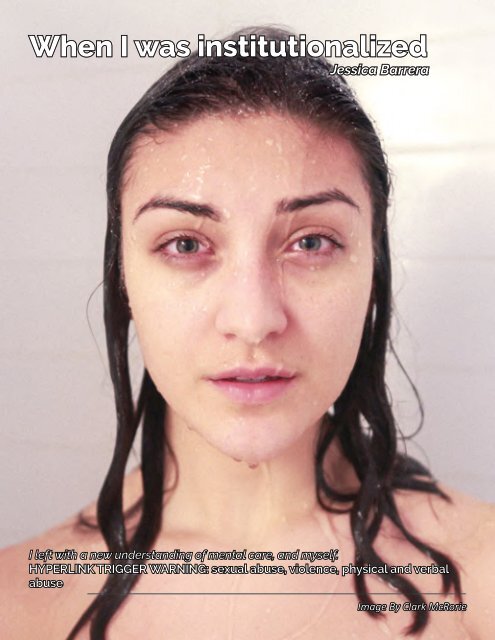Culture & Identity
You also want an ePaper? Increase the reach of your titles
YUMPU automatically turns print PDFs into web optimized ePapers that Google loves.
When I was institutionalized<br />
Jessica Barrera<br />
I left with a new understanding of mental care, and myself.<br />
HYPERLINK TRIGGER WARNING: sexual abuse, violence, physical and verbal<br />
abuse<br />
Image By Clark McRorie<br />
Minds Matter Magazine Volume III Issue I <strong>Culture</strong> & <strong>Identity</strong><br />
I step out of a hot shower and into warm,<br />
comfortable clothes. I quietly walk down the<br />
hallway, into a room where the news plays<br />
on TV. I walk to the bookshelf and choose A<br />
Million Little Pieces by James Frey from rows<br />
of novels. I take the book to my room and<br />
quietly read. I am about four pages in when<br />
I hear a knock on my door. My nurse has arrived<br />
to bring me my medication.<br />
Years of controversial treatments, mystery<br />
induced fear, and media misrepresentations<br />
have created a cultural perception in<br />
Western society that psychiatric institutions<br />
are full of padded cells, arm restraints and<br />
forced medication injections. There is also a<br />
widely held perception of psychiatric inpatients<br />
being dangerous and violent.<br />
My experience being institutionalized<br />
was vastly different. In late April 2017, I was<br />
admitted to the Centre for Addiction and<br />
Mental Health (CAMH), in downtown Toronto<br />
to be treated for a bipolar manic episode.<br />
What was a scary situation at first became a<br />
positive experience.<br />
In Western media and popular cultural<br />
perception, psychiatric institutions have been<br />
portrayed as frightening, confining buildings<br />
only for those who are severely ill or dangerous.<br />
The location where I stayed first opened<br />
as a provincially-run mental health facility in<br />
1850. It was called the Provincial Lunatic Asylum.<br />
In 1998, CAMH first formed as part of<br />
rovince-wide efforts to redesign healthcare.<br />
One of their four key challenges to address<br />
was stigma.<br />
Jennifer Bazar, a curator at Humber<br />
College’s Lakeshore Grounds Interpretive<br />
Centre, says the average Canadian today still<br />
“assumes the worst” when they think about<br />
psychiatric institutions. She says that psychiatric<br />
institutions evoke fear of the unknown<br />
and that, similar to people fascinated with<br />
exploring abandoned buildings, there is a<br />
sense of mystery behind the closed doors of<br />
institutions.<br />
“A lack of understanding perpetuates<br />
assumptions,” Bazar says. “Often our minds<br />
go to the most radical assumptions.” Ideas<br />
of institutionalization have also been widely<br />
popularized by classic films like Silence of the<br />
Lambs and One Flew over the Cuckoo’s Nest.<br />
Recent adaptations include those in American<br />
Horror Story and Pretty Little Liars.<br />
Clark McRorie, a film student at Ryerson<br />
University, says these shows and movies<br />
traditionally portray psychiatric wards in a<br />
negative light. He argues they often include<br />
“some form of torture.”<br />
“They use this setting for a horror story<br />
vibe, where you see people getting electric<br />
shock therapy or drowned in ice water, or<br />
being forced to take medication,” he says.<br />
This narrative can lead people to fear<br />
psychiatric institutions. But the week I spent<br />
at CAMH was one of the most transformative,<br />
challenging and positive experiences I<br />
have ever had.<br />
CAMH is one of the leading teaching<br />
and research institutes for mental health in<br />
the world. The morning after I was admitted,<br />
a physician gave me a physical examination<br />
- an important reminder that healing is both<br />
mental and physical. There were scheduled<br />
17






